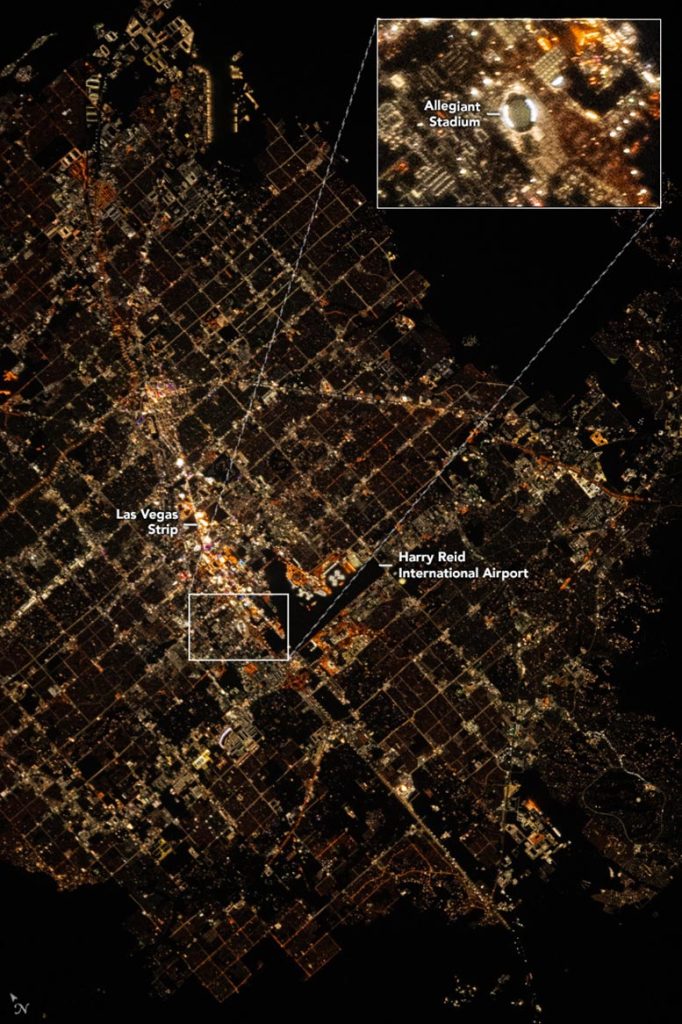
Astronaut photograph of the bright city lights of Las Vegas, including those from the stadium where the Super Bowl LVIII game will be played, captured on September 17, 2022, from the International Space Station.
A large stadium contributes to the nighttime illumination of Las Vegas, which hosts the Super Bowl for the first time in 2024.
Las Vegas knows a thing or two about putting on a show. In February 2024, the Nevada desert city will put on one of the year’s biggest shows in sports when it hosts Super Bowl LVIII. The “Big Game” will feature professional American football teams, the San Francisco 49ers and the Kansas City Chiefs, vying for the National Football League championship.
Allegiant Stadium’s Features
The bright city lights of Las Vegas, including those from the stadium where the game will be played, are visible in this photograph shot by an astronaut aboard the International Space Station. Allegiant Stadium was completed in 2020 with a price tag of nearly $2 billion. It contains 28,000 tons of structural steel, seats 65,000 people, and is enclosed on its northern side by basketball-court-sized panels that can open to views of the Las Vegas Strip. Among its sustainability features, the venue is fully powered by renewable energy, and its roof is made of a translucent material that lets in natural light while blocking the heat of the Sun.
The glaring lights of the stadium and the Strip feature prominently in the photo and contrast with the relatively dark adjacent runways of Harry Reid International Airport. Most of the bright white, saturated pixels in this photo contain a mix of light sources, said Christopher Small, a geophysicist at Columbia University who studies anthropogenic night light. Lights in more residential outlying areas tend to have warmer spectra typical of low-pressure sodium lights.
Understanding Urban Night Lights
In recent work, Small developed a method for distinguishing different lighting types within image pixels in nighttime photos from NASA’s Gateway to Astronaut Photography of Earth. He then quantified the brightness, color, and extent of urban night lights from the photographs to glean insight into how cities grow and evolve.
Growth has been a through line in Las Vegas’s story over the past several decades. The greater Las Vegas metropolitan area has added nearly 1 million people to its population since the year 2000. Its growth spurt—readily apparent from space—began decades earlier, though. A time series of Landsat images (see video below) compiled by NASA’s Scientific Visualization Studio shows the city’s outward expansion from 1972 to 2021.
Timelapse animation of Lake Mead and the city of Las Vegas, Nevada, from 1972-2021, as captured by Landsat sensors. The images are false-color, showing healthy vegetation in red.
As the city has grown, so has its footprint of night lights. But despite its reputation as the “Neon City,” Las Vegas is not all that unique in its luminosity, said Small. For example, he pointed out, “both Tokyo and Shanghai have some very impressive lightscapes, although clouds and humidity often blur the view of both cities.” Vegas benefits from its altitude and dry atmospheric conditions for clearer views from space, as in this astronaut photo.
Las Vegas experienced unusually cool and wet weather in the week leading up to the Super Bowl due to an atmospheric river moving inland from California. More typical clear skies are forecast for game time, but weather conditions should factor little into the game since the stadium is enclosed.
Credit line Astronaut photograph ISS067-E-369057 was acquired on September 17, 2022, with a Nikon D5 digital camera using a focal length of 400 millimeters. The image was provided by the ISS Crew Earth Observations Facility and the Earth Science and Remote Sensing Unit at Johnson Space Center. The image was taken by a member of the Expedition 67 crew. It has been cropped and enhanced to improve contrast, and lens artifacts have been removed. The International Space Station Program supports the laboratory as part of the ISS National Lab to help astronauts take pictures of Earth that will be of the greatest value to scientists and the public and to make those images freely available on the Internet.



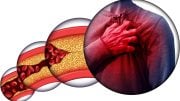
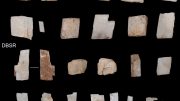
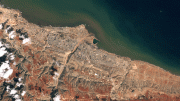
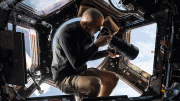
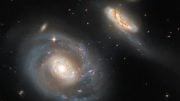

NASA is happy about “light pollution”? Their articles usually nag about climate change, for example last week’s “The Hottest Year in History: 5 Factors to Explain the Record Heat in 2023”, and here they are celebrating how some stadium and Las Vegas use electricity so inefficiently as to send light into space? According to Smart Lighting Industries in 2021, the over 12,000,000 lights on the Vegas strip cost over $1.33 million dollars per day to keep on.
Cool photo. I’d rather NASA go back to being the cool agency again, instead of the nagging, but it can’t be both ways.